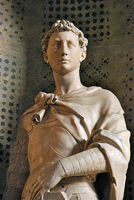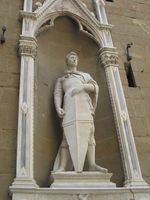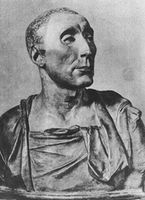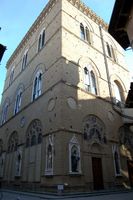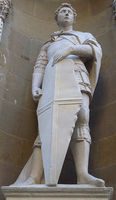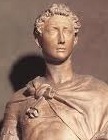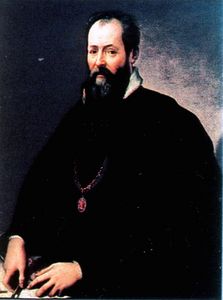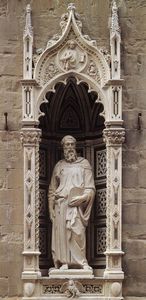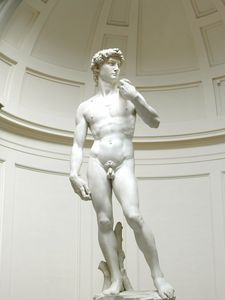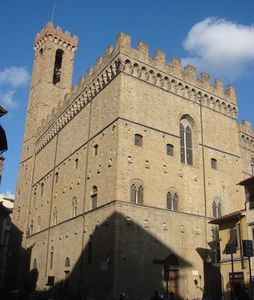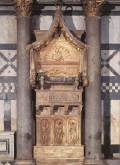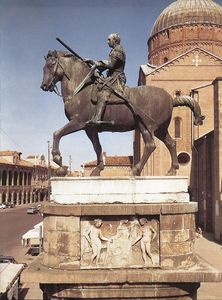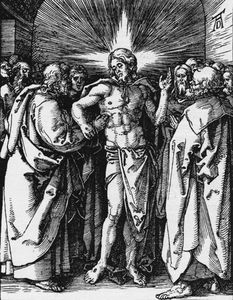St. George
- Date of Creation:
- circa 1417
- Height (cm):
- 209.00
- Medium:
- Other
- Subject:
- Figure
- Created By:
- Current Location:
- Florence, Italy
- Displayed at:
- Museo Nazionale del Bargello
St. George Story / Theme
The story of St. George is a well-known one. The town of Silene in Libya had been plagued by the presence of a dragon for years; the dragon lived just outside the town and caused death and tragedy among the townspeople for some time.
The town leaders eventually decided to begin sacrificing two sheep per day to the beast, hoping it would satisfy his taste for blood and leave the human population in peace. However, this arrangement did not placate the dragon for long and soon the locals were making human sacrifices to the dragon; all of the town's young people were entered into a grotesque lottery of sorts, and every day one would be chosen to be sacrificed.
Eventually, the king's daughter was chosen as a sacrifice. This, of course, was seriously upsetting to the king, and he sought a way to stop it. The town granted him eight days to find a solution.
Meanwhile, St. George was traveling near Silene when he encountered the princess on the road. She was distressed but resigned to her fate and told St. George what was happening. St. George pledged then and there to slay the dragon and save the princess from a gruesome and premature death. He sought out the dragon and without ceremony drew his lance and brought the dragon's reign of terror to an end.
St. George's bravery and fearlessness were celebrated along with his subsequent conversion of the entire town of Silene to Christianity. The townspeople were won over by St. George's skill and strength and believed he must be divinely favored to be able to slay the dragon that had killed and devoured so many other men.
The life of St. George is chronicled in The Golden Legend, a medieval compilation of saints' lives, and he remains an iconic Christian saint who stands for faith and courage in the face of terrible adversity.
St. George Inspirations
St. George is still a source of inspiration for millions, both Christian and non-Christian and his heroic feats are evidence of the strength of his faith in God and his determination to fight evil.
Donatello was commissioned to sculpt St. George by the armorers guild of Florence. The statue was to decorate the guild's niche at the newly-constructed Orsanmichele, a new marketing hall.
This piece was obviously meant to portray a youthful, courageous St. George, and few will dispute that Donatello's creation was anything but excellent.
Scholars of this time may also have influenced Donatello's choice of subject for the guild's niche. Scholars of the fifteenth century were extremely interested in educating and providing a good example for young Florentine men. Widely regarded as troublemakers and difficult to tame, the young men of Florence often married late and spent much of their youth getting into various scrapes.
Many believe that the St. George statue is meant to be a fusion of both modern and classical ideals; a marble version of the quintessential classical hero. For this reason, some scholars think that Donatello chose St. George to help set an example for the city's youth.
It's possible that the St. George may also have been a response to the rapacious activity of the hated Visconti clan of Milan, who repeatedly attacked and tried to annex Florence (and more than once nearly succeeded). Some believe that Donatello crafted the St. George more as an attempt to forge a sense of community and civic identity than to honor the Christian saint.
The Florentine people identified overwhelmingly with their Roman heritage and the heroes and leaders that Rome produced. Thus, a statue honoring that heritage would have been both timely and appropriate.
Whatever the inspiration for the St. George, it was and still is a treasured work of art that celebrates many shared values and ideals.
St. George Analysis
Features:
The St. George is widely regarded as a tribute to the classical heroes of antiquity. His features are strong and masculine, yet delicate and youthful, as Florentines of the period liked to imagine the fabled heroes of the past.
Pose:
Allegedly, Donatello sculpted St. George as he was thought to have been just moments before encountering and slaying the dragon. He appears deep in thought; his expression is slightly hesitant, yet determined and fearless.
Scholars debate the nature of his pose, but it is generally accepted that the St. George is in contrapposto, leaning on his left leg. His left arm is curled out in front of his body, coming to rest on the top of his shield.
Clothing:
For a man about to fight a dragon, St. George is rather modestly armed and clad. He is wearing only a chest plate, cloak, plate skirt, boots and gloves. He holds a shield in front of him and the fingers of his right hand are curled as if holding something (originally, probably a lance or a sword).
The leather thongs at St. George's knees and shoulders were probably meant as a subtle tribute to Rome; as armor they have no practical value.
Texture:
Among other things, Donatello is frequently praised with regard to the St. George because of his ability to almost magically change the texture of his medium according to what he was sculpting: the St. George is composed of bronze cloth, metal, leather, flesh and hair.
Observing each part of the statue, however, one gets the feeling of looking at actual cloth, metal, leather, flesh, and hair - not bronze renderings thereof. This is further evidence of Donatello's commitment to absolute realism: he believed that hair sculpted with bronze or marble should still look like hair.
St. George Critical Reception
As one of the most (if not the most) talented and influential sculptors of the Florentine Renaissance, Donatello's works were universally acclaimed and the St. George is no exception. Although it was constructed for a lesser guild and not allowed to be crafted in expensive, prestigious bronze, the statue Donatello created for the armorers guild at Orsanmichele is an incredible accomplishment, a lovely tribute to Roman heroism, and a magnificent adornment to the church.
Like all of Donatello's works and the majority of biographical information about Donatello himself, there is very little information regarding how the St. George was initially received. However, it is known that the statue occupied its niche in the Orsanmichele for many years, and surely it would not have if it were not an honored and highly prized piece of art.
For its time, the St. George was revolutionary and very unique. Donatello possessed a fantastic ability to make bronze look like whatever he was sculpting - hair, clothing, etc. - and an admiration for the classical heroes of the old Roman Empire.
The citizens of Florence considered themselves the heirs of the beauty, grace and power of the Roman Empire and most highly valued any tribute thereto. Thus, it is likely that both the guild members and the citizens of Florence welcomed the statue.
Scholars are united in their admiration for the St. George and are divided only when it comes to evaluating what the statue ultimately meant to Donatello and the Florentine people.
In the sixteenth century, Giorgio Vasari wrote of Donatello's St. George, "Life itself seems to be stirring vigorously within the stone. And to be sure no modern statues have the vivacity and spirit produced by nature and art, through the hand of Donatello in this marble."
St. George Related Sculptures
St. George Locations Through Time - Notable Sales
St. George Artist
Donatello was a Florentine sculptor born to a wool-carder toward the end of the fourteenth century. He blossomed quickly as an artist and, after working briefly in a goldsmith's shop, was apprenticed to Italian master Lorenzo Ghiberti around the age of fifteen.
Donatello's apprenticeship did not last long; he was eager for professional independence and at the age of 17 left his master to travel to Rome with architect Filippo Brunelleschi. The two maintained a lifelong friendly rivalry.
Back in Florence, Donatello's fame and wealth grew exponentially over the years. He developed a close personal relationship with the wealthiest family in Florence, the de Medicis, and spent much of his professional life sculpting at the whim of Cosimo, the family patriarch.
St. George is among Donatello's most noted works and ther examples include Mary Magdalen, St. Mark, Judith and Holofernes and Gattemelata. Donatello worked up until his death in 1466, leaving an indelible impression on the emerging Renaissance and the history of Western art.
St. George Art Period
The St. George was painted in a time of slow but steady transition from the cumbersome, stylized International Gothic style to the true Renaissance. Donatello studied classical art throughout his childhood and formative years and is famous for having developed a style that so perfectly and uniquely blended both into a technique that countless artists have attempted to imitate.
The International Gothic style emphasized highly stylized renderings of all things, both human and non-human. Artists presented their subjects and environment as flawlessly as possible. Donatello disliked this unrealistic approach to art and concentrated instead on presenting his subjects more naturally.
Virtually all of Donatello's subjects are presented in contrapposto - another way of saying 'natural pose'. With Donatello's innovative and creative spirit, the art world was finally ushered into the High Renaissance.
St. George Bibliography
To read more about Donatello please choose from the following recommended sources.
• Bennett, Bonnie A. & Wilkins, David G. Donatello. Moyer Bell Limited, 1985
• Janson, H. W. Sculpture of Donatello. Princeton University Press, 1979
• Lightbown, R. W. Donatello and Michelozzo: Artistic Partnership and Its Patrons in the Early Renaissance. Harvey Miller Publishers, 1980
• Lubbock, Jules. Storytelling in Christian Art from Giotto to Donatello. Yale University Press, 2006
• Poeschke, Joachim. Donatello and His World: Sculpture of the Italian Renaissance. Harry N Abrams, 1993
• Pope-Hennessy, John Wyndham. Donatello: Sculptor. Abbeville Press, 1993
• Rea, Hope. Donatello. Forgotten Books, 2010
• Scott, Leader. Ghiberti and Donatello: With Other Early Italian Sculptors. Bibliolife, 2008


